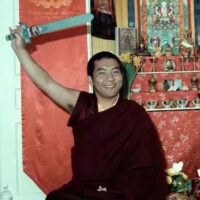What does it mean to practice shamatha and vipashyana together? Shamatha involves letting the mind rest on an object in a state of concentration. Both mind and object lack ultimate reality. This true nature is present at all times, not only when one achieves insight into it through vipashyana meditation. Maintaining this awareness or insight in shamatha meditation – that is, not separating one-pointedness from awareness — is the unity of shamatha and vipashyana.
When a feeling or thought arises, what does it mean to unite “calmness movement, and awareness” through shamatha and vipashyana? Let us take the arising of anger as an example. First one notices that anger has arisen and acknowledges it. This corresponds to shamatha or mental calmness, that is, mindfulness which allows one to notice that a feeling has arisen. Based on this, one examines the feeling or thought by means of vipashyana. Calmness, movement, and awareness are the three phases that one examines. Calmness corresponds to the question: “where does the feeling or thought dwell?,” movement to the question: ”where does the feeling or thought go to?,” and awareness to the question: “what is present between the arising and the subsiding of the thought or feeling?” This form of investigation brings one to the realization that the feeling has no real existence.

3rd Jamgon Kongtrul Rinpoche
from the book Cloudless Sky: The Mahamudra Path of the Tibetan Buddhist Kagyu School
Read a random quote or see all quotes by the 3rd Jamgon Kongtrul Rinpoche.
Further quotes from the book Cloudless Sky:
- How does confusion arise
- Failing to recognize one’s own mind
- Dharmadhatu
- Beyond meditation
- Emptiness and dependent origination